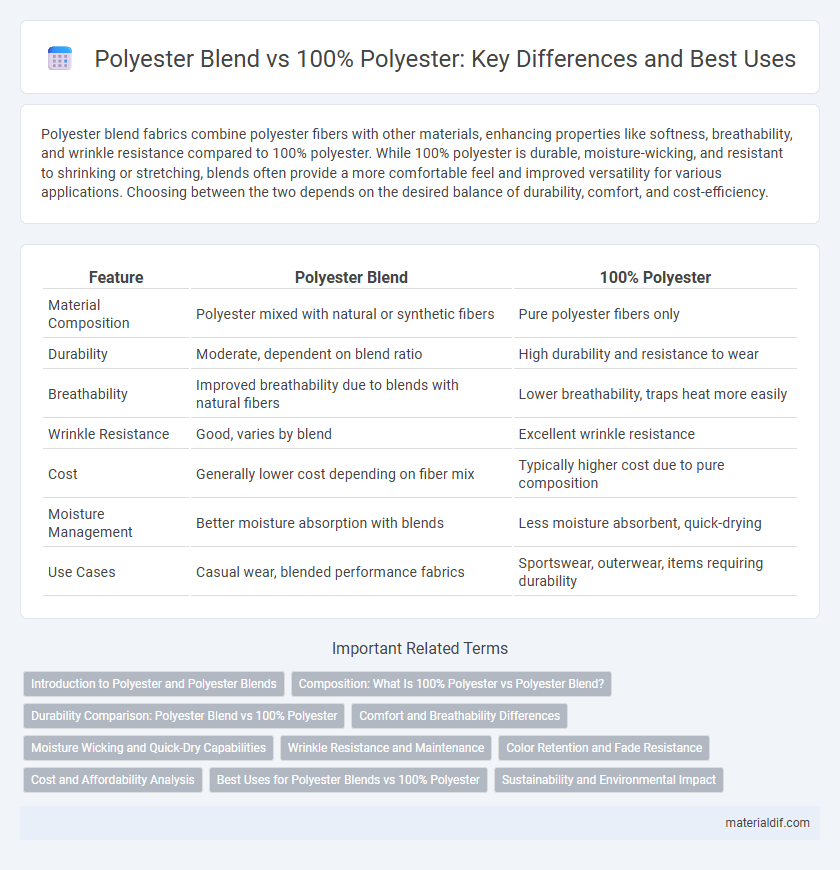Polyester blend fabrics combine polyester fibers with other materials, enhancing properties like softness, breathability, and wrinkle resistance compared to 100% polyester. While 100% polyester is durable, moisture-wicking, and resistant to shrinking or stretching, blends often provide a more comfortable feel and improved versatility for various applications. Choosing between the two depends on the desired balance of durability, comfort, and cost-efficiency.
Table of Comparison
| Feature | Polyester Blend | 100% Polyester |
|---|---|---|
| Material Composition | Polyester mixed with natural or synthetic fibers | Pure polyester fibers only |
| Durability | Moderate, dependent on blend ratio | High durability and resistance to wear |
| Breathability | Improved breathability due to blends with natural fibers | Lower breathability, traps heat more easily |
| Wrinkle Resistance | Good, varies by blend | Excellent wrinkle resistance |
| Cost | Generally lower cost depending on fiber mix | Typically higher cost due to pure composition |
| Moisture Management | Better moisture absorption with blends | Less moisture absorbent, quick-drying |
| Use Cases | Casual wear, blended performance fabrics | Sportswear, outerwear, items requiring durability |
Introduction to Polyester and Polyester Blends
Polyester is a synthetic fiber known for its durability, wrinkle resistance, and moisture-wicking properties, making it a popular choice in textiles. Polyester blends combine polyester with natural fibers like cotton or wool to enhance comfort, breathability, and texture while retaining polyester's strength and quick-drying features. These blends offer a balance of performance and comfort, suitable for various applications from apparel to home furnishings.
Composition: What Is 100% Polyester vs Polyester Blend?
100% polyester fabric consists entirely of synthetic polyester fibers, providing consistent durability, moisture resistance, and wrinkle control. Polyester blends combine polyester with natural fibers like cotton or wool, enhancing breathability, comfort, and texture while maintaining some synthetic benefits. The composition impacts the fabric's performance, care requirements, and suitability for specific uses such as sportswear or formal attire.
Durability Comparison: Polyester Blend vs 100% Polyester
Polyester blends often combine polyester with natural fibers like cotton, enhancing softness and breathability while maintaining reasonable durability. 100% polyester fabrics typically exhibit superior strength, resistance to stretching, shrinking, and abrasion compared to polyester blends. In high-wear applications, pure polyester offers longer-lasting performance due to its robust synthetic fiber structure.
Comfort and Breathability Differences
Polyester blends often combine polyester with natural fibers like cotton, enhancing comfort and breathability compared to 100% polyester, which can trap heat and moisture. Blended fabrics improve moisture-wicking properties and allow better airflow, reducing sweat accumulation and skin irritation. While 100% polyester excels in durability and wrinkle resistance, polyester blends provide a softer, more breathable feel ideal for prolonged wear in warm conditions.
Moisture Wicking and Quick-Dry Capabilities
Polyester blends often enhance moisture-wicking and quick-dry capabilities by combining synthetic fibers with natural or other materials, improving breathability and comfort compared to 100% polyester. While 100% polyester excels in moisture management due to its hydrophobic properties, blends optimize performance by balancing durability and softness. These characteristics make polyester blends more versatile for activewear seeking efficient sweat evaporation and rapid drying.
Wrinkle Resistance and Maintenance
Polyester blend fabrics typically offer enhanced wrinkle resistance compared to 100% polyester by combining fibers that contribute to durability and easier care. Blended materials often require less ironing and maintain shape better after washing, reducing maintenance time for consumers. In contrast, 100% polyester excels in durability and stain resistance but may show wrinkles more prominently without blend fibers to improve smoothness.
Color Retention and Fade Resistance
Polyester blends offer improved color retention by combining polyester's inherent dye affinity with fibers that enhance fabric strength and softness, reducing fade over time. 100% polyester fabrics exhibit superior fade resistance due to their synthetic nature, which resists UV exposure and moisture better than natural fibers. Choosing between polyester blend and 100% polyester depends on the balance desired between durability, comfort, and long-lasting vibrant colors.
Cost and Affordability Analysis
Polyester blend fabrics typically offer a more cost-effective option compared to 100% polyester, as the inclusion of other fibers like cotton or rayon reduces overall material expenses. While 100% polyester often provides durability and moisture-wicking properties, polyester blends balance performance with affordability, making them popular in budget-conscious apparel manufacturing. The cost savings in polyester blends arise from lower raw material costs and enhanced fabric versatility, appealing to consumers seeking durable yet economical clothing choices.
Best Uses for Polyester Blends vs 100% Polyester
Polyester blends combine polyester with natural fibers like cotton or wool, enhancing breathability and comfort, making them ideal for casual wear, sports apparel, and versatile everyday clothing. 100% polyester offers superior durability, wrinkle resistance, and moisture-wicking properties, best suited for activewear, outdoor gear, and performance uniforms. Choosing between polyester blends and pure polyester depends on desired fabric feel, durability, and specific use cases in fashion or functional wear.
Sustainability and Environmental Impact
Polyester blends typically combine polyester fibers with natural or synthetic materials, reducing the overall reliance on petroleum-based fibers compared to 100% polyester, which is fully petroleum-derived and non-biodegradable. The production of 100% polyester emits higher levels of greenhouse gases and contributes more significantly to microplastic pollution during washing cycles. Choosing polyester blends that include sustainable fibers like organic cotton or recycled polyester can lower environmental impact by enhancing biodegradability and reducing resource consumption.
Polyester Blend vs 100% Polyester Infographic

 materialdif.com
materialdif.com